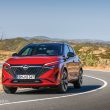Tell us about the founding and the inception and Journey of GHM:
In the initial phase, GHM Motors was planning to explore options like vans, cars, etc. in vehicle industry. However, we witnessed that the transportation landscape was majorly changing and enhancing in terms of innovation. We hence focused on electric vehicles as our ultimate goal was to make a difference for people with disabilities, and that’s how we got started. It all started when a physically challenged person approached us when we were making three-wheelers and asked if we could customise a tri-cycle for them. Later, the response we got from that person was amazing. We could bring some change in the city by doing it this way and that added on to our principles. So, we thought of doing it on a large scale and that was such a huge success that we bagged 5 government partnerships. (Telangana, Andhra Pradesh, Maharashtra, Odisha, Chhattisgarh) Our mission is to combine innovation, sustainability and accessibility.
We’ve made a lot of progress in the automotive industry, from being pioneers to continuously improving our technology, reach and design. One of our proudest accomplishments is being on Shark Tank India’s Season 2, where we showed off our products and showed our commitment to making a big impact in the electric mobility space, in line with India’s Make in India policy.
2. India’s EV industry is expanding, what is your call about specifically for bicycles?
As India’s electric vehicle (EV) market continues to grow, e-bikes have the potential to revolutionize the way we travel in cities. In fact, in 2022, three times more EVs were registered than in 2021, suggesting that e-cars may become the new norm. The sale of e-bikes in India reached 2,31,338 in 2022, and is projected to increase to 24,64,750 in 2027. This indicates that more people are considering e-bikes as a viable option for daily commuting, as they are accessible, eco-friendly, and provide health benefits. Additionally, electric bicycles have the potential to reduce traffic, reduce carbon emissions, and reduce pollution in urban areas, making them an ideal option for small to medium-distance commuting.
How should the distribution model be planned as per the size of the Indian market?
It is essential to understand the needs and preferences of different regions in order to develop an effective distribution mechanism that is suitable for the market in India. A hybrid distribution strategy that combines offline and online channels works very well in urban areas where space limitations and traffic jam are common. Physical stores offer a hands-on experience while online platforms are easy for tech-literate consumers.
Partnering with local dealers in Tier 2 and Tier 3 cities where face-to-face interaction is important, can lead to better outreach.
We strive to be everywhere and make electric bicycles available in both urban & rural areas. Our goal is to build brand awareness about our electric bicycles all over the country by building a cohesive distribution network.
How much R&D went into the product, what was your outlook on making electric motorcycles indigenous in India?
We have invested a considerable amount of time and resources in research and development in support of our mission. Our team has conducted extensive research and development activities over a period of 5-6 years, covering a wide range of topics related to technology, including battery development, motor development, controller tuning, and more. Our aim is to deliver an outstanding user experience that increases the comfort and efficiency of our electric motorcycles.
We are committed to developing electric motorcycles in India, with the aim of contributing to the country’s technological prowess and self-reliance. Our company’s DNA is steeped in the ethos of Make In India, which encourages the development of local components and the cultivation of design and engineering talent. Through this, we contribute to the growth of the country’s economy and influence the trajectory of electric mobility.
Do you have plans to foray into the International Market?
The international market is an appealing one for GHM Motors. Clients from around the world are eager to explore the potential of electric bicycles in places such as Europe, the United States, and New Zealand, as well as South Asian countries such as Bangladesh and Sri Lanka. To ensure compliance with global standards and laws, GHM Motors is focusing on improving its products. Our approach to entering these markets is to focus on areas in which electric bicycles are already popular. By demonstrating the scientific progress and sustainability that GHM Motors stands for, we are aiming to establish a strong international presence and contribute to the global shift towards environmentally friendly transportation options.
Who are the target customers that you envision using the available models?
Our range of e-bike models is designed to meet the needs of a wide range of customers, each with their own unique needs and preferences. For example, the L 2.0 model is aimed at those aged 13-22, primarily college students, who seek a convenient and stylish way to get around. The I model is designed for delivery, appealing to those aged 27-40 and providing a practical and environmentally friendly solution for businesses such as food delivery services. Our F model is versatile and adaptable, meeting the needs of those aged 18-45 who desire an all-purpose e-bike for everyday use. This type of e-bike provides a practical and stylish way to travel for the business world. Finally, our E model is a combination of comfort and style, providing a seamless and effortless ride for medium distances, making it the ideal electric bicycle for those seeking the best e-bike experience.
What kind of infrastructural assistance is required by our cities in India to enable EV micro-mobility?
Indian cities should prioritize improving the infrastructure that facilitates cycling as a practical form of transportation in order to increase the adoption of electric bicycles (EV micro-mobility). The ease of charging infrastructure is essential for users of electric bicycles to be able to take advantage of the service. To ensure cyclists have safe routes and reduce traffic congestion, it is essential that dedicated bike lanes are included in municipal planning.
Public awareness campaigns may help to further promote the use of electric bicycles. Cities can draw more people’s attention to the sustainability of electric bicycles by emphasizing the health, environmental, and convenience benefits of these vehicles. Furthermore, it may be easier for consumers to transition to eco-friendly commuting options if measures are taken to facilitate communication between electric bicycle and public transportation systems.










